Tape worms (Flat worms)
Introduction
The term Tapeworm refers to the flat shape of the worm parasite.äTapeworms are flat. Their body consists of a chain of visible segments, occurring one after the other. Terminal mature segments contain worm eggs; they are disconnected and excreted and can be seen in the faeces of infected animals. When a tapeworm dies the whole long worm can be excreted in one piece. The head part contains hooks, or suckers. Tapeworm eggs are of microscopic size and invisible to the eye.
Adult tapeworms in the intestine have little effect on the health of adult farm animals. Large numbers of tapeworms in the intestines of young animals may cause stunting and occasionally trigger severe colic.
The general life cycle of tapeworms occurs in two hosts, the final host (e.g. dog) and the intermediate host (e.g. cow).
Life cycle of tapeworms that live in the intestines of cattle, sheep and goats
The eggs of mature tapeworms that live inside the intestine of a cow, sheep or goat (final host) can only develop into another adult tapeworm after going through an intermediate stage inside the organs of an intermediate host. The intermediate hosts of the common tapeworms of ruminants are small mites that live on the pasture and are ingested by the final host during grazing.
1. Monieza benedeni
Monieza is found in the intestine of cattle, sheep, goats and occurs in most parts of the world. The life cycle includes the final host (ruminant) and the intermediate host - small mites living in large numbers on the pasture. These mites are eaten by grazing animals and develop in the intestine into adult tapeworms. The adult tapeworm is 1-6 meters long, 16mm wide and lives for only about 3 months in the final host. When the tapeworm dies it is shed with the faeces.
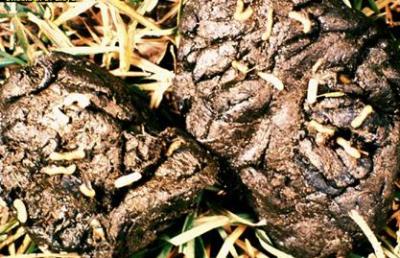 |
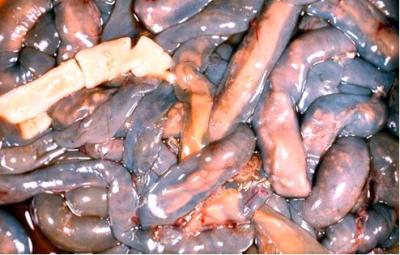 |
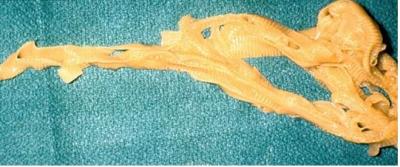 |
| Monieza tapeworm segments in calf dung- segments are wider than long | Monieza in lamb intestine | Knot of worms from intestine-segments are wider than long |
| © Sheelagh S. Lloyd |
© Sheelagh S. Lloyd
|
© Sheelagh S. Lloyd |
2. Avittelina species
These occur in the small intestines of cattle and other ruminants. They are present mainly in Africa and India. The adult tape worm measures about 3 meters long and 3mm wide.
3. Thysaniezia giardi
This occurs in the small intestine of cattle, sheep and goats, mainly in Africa. The life cycle is through oribatid mites.
Clinical signs of adult tapeworm infection
Tapeworms in the intestine of adult cattle, sheep or goats do not cause any serious disease. Very large numbers of tapeworms in the intestine of calves and lambs can lead to stunting, pot belly, diarrhoea and constipation and also colic due to obstruction of the intestinal passage.
Diagnosis
This is made by observing tapeworm segments in the faeces or intestines, or in the laboratory by checking under the microscope for the presence of tapeworm eggs in the faeces.
At slaughter
- Tapeworms may be present in the intestine or in the bile ducts.
- The carcass may be pale and thin
- The walls of the intestines may show ulcerations and inflammation caused by hooks of tapeworms
- Tapeworm segments or a whole adult tapeworm can be seen in the faeces.
Prevention and Treatment
There are no preventive measures against tapeworms living in the intestine of ruminants.
Treatment
As the tapeworm has a limited lifespan and is excreted with the faeces it is not necessary to treat adult cattle, sheep and goats against tapeworms. Treatment may become necessary in heavily infected young calves, lambs and kids. Some broad spectrum anthelmintics are also active against tapeworms (see below).
- Use of anthelminthic drugs that also act on tapeworms is the only effective treatment method (read label and instructions carefully, some anthelminthic drugs have no effect on tapeworms!).
- Niclosamide, Praziquantel, Albendazole, Fenbendazole, and Oxfenbendazole are effective against tapeworms in cattle, sheep and goats.
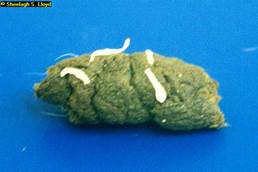 |
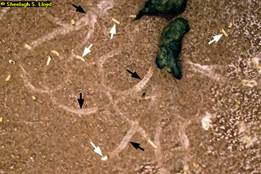 |
|
Tapeworm segments |
Taenid eggs migrating away from the faeces (white arrows) leaving a trail of eggs on the ground (black arrows) |
|
© S. Lloyd
|
© S. Lloyd |
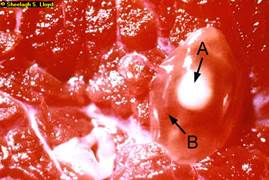 |
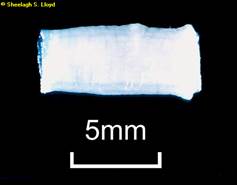 |
| Tapeworm cyst in muscle A: head, B: bladder | Tapeworm segment (longer than wide) |
|
© S. Lloyd
|
© S. Lloyd |
Tapeworms in intestines of dogs causing cysts in cattle, sheep and goats
- Tapeworms living in the intestine of dogs are of great significance as they cause cysts and dangerous chronic disease in ruminants and also in humans.
- Life cycle of tapeworms that live in the intestines of dogs and cause disease in cattle, sheep, goats and humans (!)
Dogs harbour specific tapeworms in their intestines and excrete the eggs into the environment, including onto pastures. Cattle, sheep, goats (and humans) are the intermediate hosts. If cattle, sheep and goats swallow tapeworm eggs excreted by dogs, the intermediate stages of these tapeworms develop into cysts inside the body of the cow, sheep, goat (or human). Depending on location of the cysts inside the body (often found in liver, lung, also in the brain) this has very serious effects on the health, leading to chronic and ultimately deadly disease.
The adult tapeworm lives in the intestine of the dog (final host) and produce eggs, which are excreted inside the tapeworm segments (called proglotid). After the segments have been shed with the faeces they disintegrate and release invisible eggs into the environment. These eggs can survive for a long time on the pasture. The invisible eggs are then eaten by the cow, sheep, goat (intermediate host) during grazing and transform into a cyst.
The most dangerous tapeworm found in dogs is Echinococcus. The adults of this small species of tapeworm live in the intestine of the dog (final host), causing almost no harm to the dog. Eggs are shed in dog faeces, then ingested by intermediate hosts (cattle, sheep, goats, humans) and develop into cysts in the organs of the intermediate host (esp. liver, lung, also brain). These so called hydatid cysts continue to grow and also form multiple daughter cysts, causing severe damage to the organs of the intermediate host.
When organs of the intermediate host containing cysts are ingested by dogs (e.g. at slaughter) the cysts will again develop into an adult tapeworm living inside the intestine of the final host (dog) and the cycle starts again.
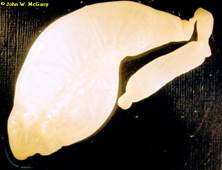 |
|
In sheep, goats, cattle and also pigs Taenia Hydatigena larva (long necked bladder worm)causes large cyst of 5-8 cm in diameter, containing a clear watery fluid often attached to the liver. © Dr. John W. McGarry and the School of Vet Science in Liverpool
|
1) Taenia hydatigena
This is a dog tapeworm and cattle, sheep, goats and also pigs are intermediate hosts. If dogs have access to the liver or peritoneal tissues of infected cattle they become infested with the adult tapeworm.
2) Larval tape worm infestation in cattle
A number of tapeworms are of significance as they involve humans and domestic dogs.
3. Echinococcus granulosus
This is a very small and short dog tapeworm.It is the most dangerous tapeworm of dogs because it forms many hydatid cysts that continue to grow in the organs of the intermediate hosts: sheep, goat, cattle and also humans. These cysts are mostly located in the liver and lungs, sometimes also in the brain. They can slowly grow to a very large size. People living in very close association with infected dogs are especially at risk.
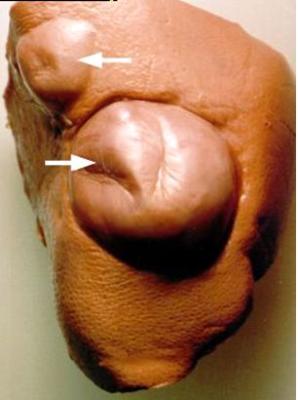 |
| Echinococcus hydatid liver cyst. Fluid filled large opaque cyst, the most common diameter being 5.0 - 10.0 cm. When mature, cysts may reach 0.5 meter in diameter depending on available space |
|
© Dr. John W. McGarry and the School of Vet Science in Liverpool
|
Symptoms of Tapeworm cysts in the intermediate hosts
Tapeworms have no apparent effect in the dog (main host).
In intermediate hosts (sheep, goat, cattle, human) symptoms vary depending on the organ of the body which is affected. Coenurus cerebralis, can reach the brain of intermediate hosts and cause staggering, blindness, head deviation, stumbling and paralysis. This condition is known in livestock as gid or sturdy. Palpation of the skull may reveal a soft spot and in very few cases it may be possible for a skilled veterinary surgeon to remove the cyst. Echinococcus cysts cause symptoms that depend very much on the location of the cysts; symptoms can be central nervous (circling disease in sheep) or chronic, when cysts are located in the liver or lung.
Diagnosis
Lesions in livestock are normally found during meat inspection.
Prevention and control of Tapeworms in dogs
Dogs must never be fed raw slaughterhouse offal (lung, liver) or raw brain tissue from ruminants.
Dogs must be dewormed regularly (4xper year) with an anthelmintic drug that is effective against tapeworms (read label and instructions carefully, some anthelmintic drugs have no effect on tapeworms!).
After slaughter it is important to dispose of and/or destroy all condemned organs and tissues that contain cysts in such a way, that dogs and other scavengers (Hyena) cannot gain access.
Ensure the following:
- Regular deworming of dogs against tapeworms
- Good meat inspection procedures by qualified meat inspectors and destruction or correct and safe disposal of infected tissues and meat (dispose offals into deep concrete pit that can be closed properly)
- Fencing of slaughter houses with dog proof fences will keep stray dogs away and prevent them from eating condemned meat that may be infected with cysts.
- When living in association with dogs, observe strict personal hygiene: always wash your hands thoroughly with soap after having contact with the dog. Always wash your hands thoroughly with soap before preparing food or eating. Children playing with dogs are at a particularly high risk of infection! Infected dogs licking children’s hands or faces can transmit the tapeworm eggs to them! Dogs living close to children must be dewormed very regularly.
Treatment of tapeworm cysts
Treatment of tapeworm cysts is not possible in livestock.
Treatment of hydatid cysts in humans is difficult and sometimes requires surgical removal of thr cysts. Treatment is not always successful – in such cases the disease is fatal – the patient dies!
Tapeworms in the intestines of humans
Taenia saginata
This is a tapeworm of humans, it causes abdominal discomfort. It is a very long tapeworm, growing up to 15 metres long. Cattle are the main intermediate hosts. In cattle the cysts are located in skeletal and heart muscle tissue where they appear as small white oval nodules, visible to the naked eye. These, if swallowed by a human, will again develop into a mature tapeworm. The tapeworm stage in cattle is also called measles. When measles are found at meat inspection the carcass can be detained and kept frozen below -10˚C for minimum 10 days to destroy the cysts. Alternatively infected meat can also be properly cooked to make it safe for human consumption. Carcasses with measles are either condemned or fetch a very low price. Eating raw or undercooked meat that has not undergone meat inspection is highly dangerous and can result in infestation with Taenia saginata. Most measles are found in the heart, tongue, diaphragm and cheek muscles of cattle.
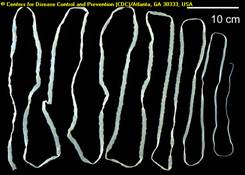 |
|
Adult Taenia saginata tapeworm, note scale. Humans become infected by eating raw or undercooked infected meat. In the human intestine the cysts (larval stage) develop over 2 months into adult tapeworms which can survive for years. They attach to and feed from the small intestine.
|
|
© Center for Disease Control CDC Atlanta/Georgia
|
Prevention
- Use of pit latrines to keep human waste away from pastures and grazing animals. The public should also be enlightened about the dangers of using human waste as fertilizer.
- Educating the public about the dangers of eating raw or partially cooked meat. The meat to be eaten by humans must be cooked properly or must be frozen below -10˚C for minimum 10 days to kill the cysts.
- Infected humans must be identified through laboratory tests and treated against tapeworms.
